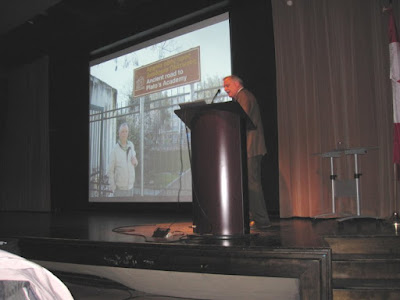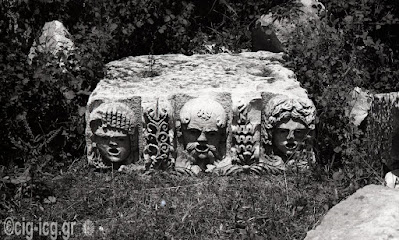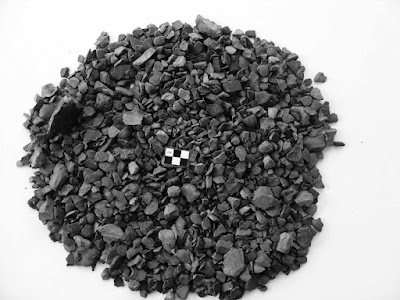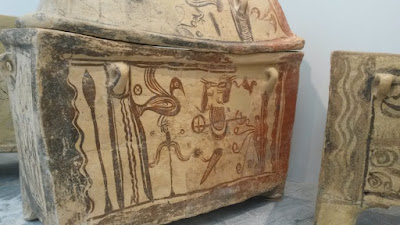The past three months have been a whirlwind of new and exciting experiences. I have had the pleasure of acting as the Intern at the Canadian Institute in Greece for the Fall semester on behalf of Wilfrid Laurier University. Over the past three months, I worked to complete my tasks at the CIG, complete two online courses offered through WLU, and take advantage of my time in this country trying to see as many things as possible. Being granted this opportunity I have had the chance to immerse myself in Athenian culture and visit many of the archaeological sites that I have learned so much about in school. This internship has allowed me to gain a first-hand perspective into many aspects of archaeology that I otherwise would not have had the opportunity to experience. Studying ancient Greek archaeology in a classroom is vastly different than getting out and actually seeing the temples and artifacts for myself. This internship has provided me with valuable connections, skills, and experiences that have greatly contributed to my passion for archaeology and left me with a desire to pursue the aspects I enjoy the most.
I had a variety of tasks that I completed throughout my internship at the CIG. Namely, I worked on the digitization of the Khostia Archive. In my first week, I was handed two large accordion style folders containing documents from the almost 40 year old archaeological project and it was my job to scan and electronically file each and every one. I was tasked with the responsibility of creating a unique system with which to name each individual file as it was scanned so it could be systematically stored. My problem solving skills and patience were put to the test as I developed a 20-digit coding system to name all 3074 documents. After countless hours of scanning spaced throughout my three months, I managed to complete the digitization of the Khostia archive and was also able to physically organize the records. One of my roles as the intern was to assist in the facilitation of the Fall lecture events hosted by the CIG. It was my responsibility to prepare the food, with the help of the fellows of course, and pour drinks at the reception. I met many great people at these events and heard many talks on a variety of interesting topics.Throughout my time in Greece, I have been fortunate enough to travel to some of the important archaeological sites as well as visit six islands. In Athens, I visited all the major sites including the Acropolis, the Athenian Agora, the Roman Forum, and Hadrian’s Library, among many others. Of course, I couldn’t just leave it at that and made stops at many of the fantastic museums hosted by this city. My favourite museum to visit was the National Archaeological Museum where I pushed my way through the crowd to see the infamous mask of Agamemnon and the boxing boys fresco. Since I mentioned in my original blog post that I had aspirations of visiting some of the Greek islands, I just had to carry this out to the next level and ended going to a total of six islands. The first island I visited was Mykonos where I met up with a fellow Laurier Goldenhawk who took me scuba diving for the first time. While on Mykonos I took advantage of its proximity to the island of Delos and made the trip to visit the archaeological site. I was blown away by the sheer size and beautiful location of the site and found myself running around in awe.
The next island I visited was the picturesque Santorini where I went full out tourist and rented an ATV, went cliff jumping (even though it was almost November), and watched the sunrise over Oia. Of course, I couldn’t miss the opportunity and visited the Bronze Age site of Akrotiri. Somehow, I found the time to make day trips to the Islands of Aegina and Hydra. I rented another ATV on Aegina and raced around the island visiting the Byzantine ghost town of Paleochora, the Temple of Aphaia, and the beach to go swimming. In my last efforts to squeeze everything in before I have to unfortunately return to snowy Canada, I ventured to Crete. On my three day adventure, I tried to visit as many things as possible and was able to see the Minoan Palaces of Knossos and Malia, as well as the Venetian fortress in Heraklion and the Heraklion Archaeological Museum. Despite the fact that it was December, I managed to go for one last swim in the Mediterranean Sea at a deserted beach in Malia. I was also fortunate enough to make trips to visit the Temple of Poseidon at Sounio, Delphi, and Ancient Corinth, thanks to one of the Fellows, Mark.Throughout my time in Greece I have had the opportunity to further explore my love for archaeology and delve into aspects that I had not yet pursued. My internship at the Canadian Institute taught me many valuable skills, especially how to carefully balance school, work, and leisure. I could not have asked for a better overall experience. I have learned so much throughout my time here and have been able to meet so many great people. I will always remember the memories I made here as well as the people I shared them with. I would like to express my thanks towards Jonathan Tomlinson and David Rupp for providing me with this internship, as well as Dr. Schaus for granting me this opportunity.Ailidh HathwayWilfrid Laurier University, Fall Intern 2016


















































